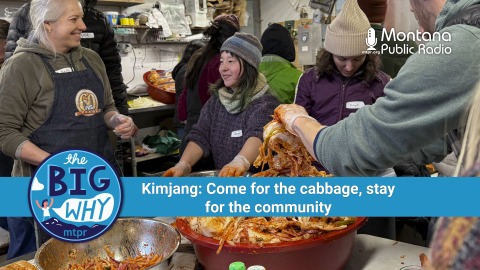Austin Amestoy Welcome to The Big Why, a series from Montana Public Radio where we find out what we can discover together. I'm your host, Austin Amestoy. This is a show about listener powered reporting. We'll answer questions large or small about anything under the Big Sky. By Montanans, for Montana, this is The Big Why.
For this episode, our Southwest Montana Reporter John Hooks is back. Welcome, John.
John Hooks Thanks for having me.
Austin Amestoy So what are we digging into this time around?
John Hooks The question this week is one I was well-situated for at my home base here in Butte. A listener wanted to know what is the story behind the Pekin Noodle Parlor?
Austin Amestoy Huh. Well, I've definitely heard that name before, and I'm not even a Butte guy. So what's the story?
John Hooks The Pekin is an institution in Butte, which I experienced on a guided visit with the current owner, Jerry Tam.
It's a Chinese restaurant on the top floor of this old building in uptown, filled with these closed-curtain private dining booths.
But what's really significant about it is that it is the oldest, continually operating family owned Chinese restaurant in the country, kept running by members of the Tam family for over a century.
Austin Amestoy Wow. That sounds like a really multi-generational effort.
John Hooks Oh, absolutely. But the story behind the Pekin is not just the story of this one restaurant. It's a story about the Chinese-American experience of a distinct, authentic culture and cuisine that was created in this chaotic mixing bowl of the American West.
Austin Amestoy Well, consider me intrigued. How far back do we have to go to find the start of this story, John?
John Hooks We got to go back to the late 1800s in Butte. Butte at this time is this bustling, packed mining city, and it's full of diversity with much of its population made of immigrants from all around the world, including China.
Mark Johnson Butte's Chinese community was the largest Chinese community in the Rocky Mountain West, at about a thousand.
Austin Amestoy And who are we hearing from there, John?
John Hooks That is historian and author Mark Johnson.
Mark Johnson Chinese settlers in the West were key to building the West. You know, the American West is resource rich and labor poor. And so in the 1860s, they were actually welcomed in to help build the railroads.
Austin Amestoy Recalling my American history classes here, I believe I'm right in saying that welcoming spirit toward Chinese immigrants didn't last all that long.
John Hooks Yeah, that's exactly right. After the railroads were built, sentiment among Americans largely turned against the Chinese for many of the same reasons that fan anti-immigrant sentiment today, the belief that they were coming in and taking up jobs that belonged to Americans. In 1882, America passed the Chinese Exclusion Act, which banned Chinese immigrants coming into the country to work manual labor jobs. Here's Jerry Tam again.

Jerry Tam But there was this thing called the 'chop suey loophole'. Or if you own a business and you migrated for your family to work the business, in imports and exports and trade industries, you can come in.
John Hooks Jerry said that loophole meant Chinese restaurants started to pop up all over the nation at this time. His family started their restaurant back in 1911 with the noodle parlor on top and a complex of herbal medicine shops.
Jerry Tam This is my dad's great grandfather, his medicine cabinet. And it's still full of everything.
John Hooks Gambling houses.
Jerry Tam This is where the money lies. This is the casino cage that connects the whole Pekin.
John Hooks And other enterprises on the floors below.
Jerry Tam What really captivated America was this thing called chop suey. And chop suey was primarily invented because it was just, basically, tidbits, leftovers of any vegetables they had late night. They would mix together and then spread over any type of noodles or rice. Once that popularity kind of took over, you would see, I mean, more Chinese restaurants than there were McDonald's, they said.
John Hooks And it wasn't just big business. Those restaurants became a really key part of Chinese communities in America. They employed people and they provided a crucial connection back home to China. I think that the creation of chop suey really epitomizes this organic formation of Chinese-American cuisine and culture as something distinct and authentic, this blend of cultures and techniques and ingredients that produces something entirely new. That fusion is at the heart of the Pekin, and it's emblazoned on the neon sign out front.
Jerry Tam So that is the origin story of the Pekin. My father came here when he was 14. His great grandfather, Tam Kwong Yee, was business partners with a man named Hum Yow who basically wanted to create noodle parlors. Then this chop suey craze happened. They got on that bandwagon and created the Pekin Noodle Parlor. But the irony is, on the neon side, it just says "chop suey."

Austin Amestoy Wow. That's a pretty remarkable family legacy. They had to weather some pretty big bumps in the road over the last hundred plus years. I'll bet.
John Hooks 100%. If you think about it this way, the Tams have kept the Pekin going through two pandemics, two world wars, the Great Depression and the shutdown of Butte's underground mines; feeding countless miners, families, politicians and celebrities, and all the while maintaining a living, functioning connection to the history and origins of Chinese American culture and experience in the West. Which is something that really hit home for me when I saw another menu from an old closed-down noodle shop in Butte.
Pat Munday So this, this menu from the Mai Wah in 1925 is not terribly different than what Jerry Tam keeps alive at the Pekin today.
John Hooks That's Pat Munday. He's a longtime Butte guy and is on the board of the Mai Wah Society in town, which operates a museum dedicated to Butte's Chinese history, in a building right down the street from the Pekin that housed a noodle parlor and a mercantile back in the day.
Pat Munday So when you go to the Pekin, you are not just eating a Cantonese or a Chinese-American meal. You are performing Chinese-American. It is a ritualistic reenactment, a performance.
John Hooks Mark Johnson, the historian and author that we heard from earlier, also spoke about the significance of having these physical connections back to the roots of Chinese-American history in Montana.

Mark Johnson I think the significance is a beautiful and hard won continuity. You know, Helena at one point in time was 20% Chinese. There still are a few Chinese families around, but there's no brick and mortar places in Helena because of urban renewal and the razing of Helena's Chinatown. So in Butte, to have brick and mortar places, like the Mai Wah, where you can go in and see what it was like in a time capsule type sense, is wonderful. And then also to have the Pekin to see that it's still operating, still serving recipes that were served more than a hundred years ago, is wonderful.
Austin Amestoy And I'll bet the Pekin means something a lot more personal to Jerry Tam.
John Hooks I think he feels a lot of pride in what his dad and his family have been able to provide for the community, the jobs that they've been able to offer and the mouths that they've been able to feed.
Jerry Tam The best part about it is my dad probably have provided over 1,000, probably 5,000 jobs, you know, throughout the whole history of the Pekin. So that's one of the better immigration stories, to come here to start with nothing and to be able to provide jobs so they can provide for their families. This place has always been open, welcomed, and it's now award winning food. But back then, it was just hot food, plenty of it, and comfort. And that's what the Pekin's been known for.
Austin Amestoy Well, thanks for the story and the history lesson today, John.
John Hooks My pleasure. Thanks for having me.
Austin Amestoy: Now we want to know what makes you curious about Montana. Submit your questions below. Find us wherever you listen to podcasts and help others find the show by sharing it and leaving a review.
-
When it comes to winter driving, everyone wants their route clear and dry, and they want it done quickly. Why don't the plows come sooner or more often? Why don't they drop more salt or deicer? Why not get more drivers on the road? Tag along as a Montana snowplow driver prepares for a big winter storm and find out more about the logistical, environmental and technical challenges that come with keeping the roads clear of snow.
-
How do cabbage and spices become ingredients for community building? In Korea, the answer is kimjang, the fall tradition of making and sharing kimchi. This week on The Big Why, we visit a farm in the Bitterroot Valley where a group of Montanans came together to keep a food custom alive and find comfort and connection among the cabbage.
-
In Montana, abortion access has been at times illegal, legal, and stuck in limbo. Providers have weathered bombings and arson, advocates and opponents have battled it out in court, and citizens have passed a constitutional amendment affirming a woman's right to choose. One listener wants to know more about the history of reproductive rights in Montana. MTPR's Aaron Bolton reports on the underground networks, political violence and landmark court cases that got us to where we are today.
-
A flag's primary purpose is to be recognized from a distance. That means few colors, no lettering and a clear distinction from other flags. Ideally, it should be simple enough for a child to draw it from memory. So, how did Montana end up with such a complicated flag? Learn more in this episode of The Big Why.







